The Most Traditional Song in Korea, Arirang
South Korea's Arirang was listed as a UNESCO Intangible Cultural Heritage of Humanity in 2012, and North Korea's Arirang also became an anthropogenic heritage two years later. It is surprising that Arirang is well known enough to become a world heritage in North Korea. Arirang has hundreds of songs and thousands of lyrics collected.

경복궁을 증축할 때 전국에서 불려온 목수와 노동자들이 불렀고, 잃어버린 나라를 되찾기 위해 낯선 산야를 헤집고 다닌 독립군들도 불렀다. 올림픽, 월드컵 경기 때도 불렀다. 아리랑을 부르면 금세 하나가 되고, 가슴이 뜨거워진다.
1926년 나운규가 연출한 <아리랑>이 극장에서 상영되기 전부터 아리랑은 한반도에서 사람들의 입을 통해 불리고 있었다. 88서울올림픽 때 세계인의 눈에 소개되었고, 1993년 임권택 감독의 <서편제>가 진도아리랑을 소재로 사람들의 가슴을 흔들었다.
Even before "Arirang," directed by Na Un-gyu, was shown in theaters in 1926, Arirang was sung through people's mouths in the Korean Peninsula. It was introduced to the eyes of people around the world during the 1988 Seoul Olympics, and in 1993, director Im Kwon-taek's "Sopyonje" shook people's hearts with the theme of Jindo Arirang.
또한, 숱한 다큐멘터리와 영화를 통해 일제강점기 조국을 떠나 외국에서 독립운동한 사람들이나 이산의 아픔을 안고 살아가는 사람들이 즐겨 부른 노래였다고 소개되기도 했다.
Also, it was introduced through many documentaries and movies that it was a song enjoyed by people who left their homeland and lived in foreign countries with separate pain during the Japanese occupation period.
우리나라에는 “아리랑 아리랑 아라리요 아리랑 고개로 넘어간다~”는 일반적인 아리랑과 3대 아리랑이 있다. 정선·밀양·진도 아리랑이 그것인데 모두 특정 지역 이름을 달고 있다. 이들 지역에는 아리랑을 공연하는 전수관이 있고 매주 1회 이상 아리랑을 공연하고 있다.
In Korea, "Arirang, Arirang, Arariyo, You are going over Arirang hill" is a common lyric for all kinds of Arirang songs. There are three major Arirang songs: Jeongseon, Miryang, and Jindo Arirang. They are all named after the specific provinces where the song was sung. These regions have performance halls, and they perform Arirang more than once a week. The visitors to the concert hall are mostly tourists.

익숙한 흥겨움과 새로 만든 아리랑극 밀양아리랑
Familiar Excitement and a Newly Created Arirang Play, Miryang Arirang
김원봉, 윤세주 등 밀양 출신 독립군이 워낙 많아 밀양 사람들은 ‘일제강점기에 독립투사나 독립군들이 밀양아리랑을 즐겨 부르지 않았을까’ 하고 생각한다. 타국살이를 하는 동안 고국과 고향을 향한 그리움을 담아 불렀을 것이라는 추측이다. 이처럼 밀양아리랑에는 밀양의 역사가 담겨있다.
There are many soldiers who fought for independence from Miryang, including Kim Won-bong and Yoon Se-joo. People believe that the fighters during the Japanese occupation used to sing Miryang Arirang. It is speculated that they might have sung with longing for their home country and hometown during their life in a foreign country.
밀양시에 자리한 아리랑아트센터는 오직 밀양아리랑을 전수하고 공연하기 위해 만들어진 공간이다. 누구든지 쉽게 접근할 수 있어 밀양아리랑을 이해하고 쉽게 따라 부를 수 있도록 돕고 있다. 공연장에서는 향토 소리꾼들이 전통 밀양아리랑을 부르고, 어린이들이 현대적 감각에 맞춘 아리랑극을 보여준다.
Miryang Arirang contains the history of Miryang. The Arirang Art Center, located in Miryang City, is a space designed only to teach and perform Miryang Arirang. Anyone can easily access it, helping them understand and sing along easily. At the concert hall, performers sing traditional Miryang Arirang, and children show an Arirang play tailored to modern senses.

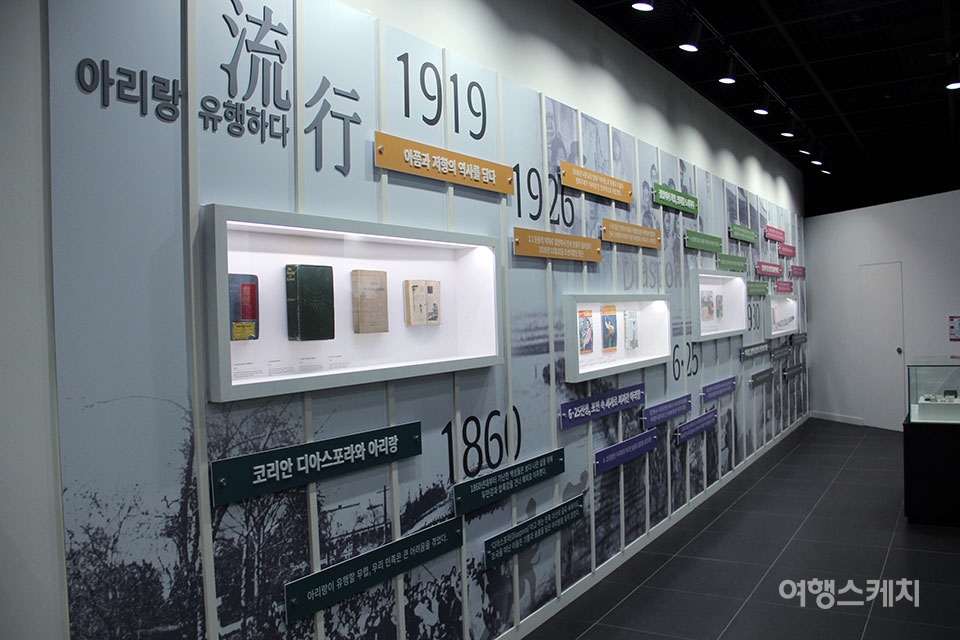
아리랑공연장에서는 매주 토요일 오후마다 공연을 한다. 아랑낭자의 가엾은 죽음을 모티브로 삼은 아랑아리랑, 조선시대 성리학의 거두 점필재 김종직 선생의 선비정신을 담은 점필재아리랑 등을 공연한다.
Arirang performance is held every Saturday afternoon. They perform "Arang Arirang," which uses the poor death of Lady Arang as its motif, and "Jumpiljae Arirang," which contains the spirit of Seonbi by Jumpiljae Kim Jong-jik, the master of Neo-Confucianism in the Joseon Dynasty.
밀양아리랑 전수관에서는 방문객이 장구 치는 법과 아리랑 가락을 가르쳐 준다. 장구나 북 같은 악기가 없어도 아리랑 장단은 맞출 수 있다. 나무꾼들은 지게와 작대기로, 밭에서 일하던 어머니들은 호밋자루로 땅을 치며 장단을 맞췄다.
In Miryang Arirang teaching hall, tourists can learn how to play Jang-gu and Arirang. Even without instruments such as jang-gu or drums, Arirang can still be played. The woodcutters used forks and sticks, and the mothers who worked in the fields hit the ground to play Arirang.
밀양아리랑의 장단은 경쾌하지만 얽혀있는 이야기는 슬프다. 과거 밀양 부사의 딸 아랑(阿娘)이 영남루로 달구경을 나온 날, 심부름꾼이 아랑에게 마음을 고백했다. 아랑이 그를 거절하자 칼로 찔러 죽였다는 것. 몇 년 후 새로 부임한 부사가 그의 꿈에 나타난 아랑의 말을 따라 시신을 찾아 장례를 치르고 범인을 색출하여 처벌하였다. 그 후 밀양의 여인들이 아랑의 정절을 사모하여 ‘아랑, 아랑’ 하고 읊조린 것이 오늘날 밀양아리랑으로 발전하였다는 것이다.
The rhythms of Miryang Arirang are light, but the intertwined story is sad. On the day that "Arang," the daughter of Mayor Miryang, came out to see the moon in Yeongnam-ro, a servant confessed his love to Arang. When Arang refused him, he stabbed her to death. A few years later, the newly appointed mayor followed Arang's words in his dream to find the body, bury it, hunt down the criminal and punish him. Later, the women of Miryang adored Arang's chastity and said, 'Arang, Arang,' which developed into Miryang Arirang today.
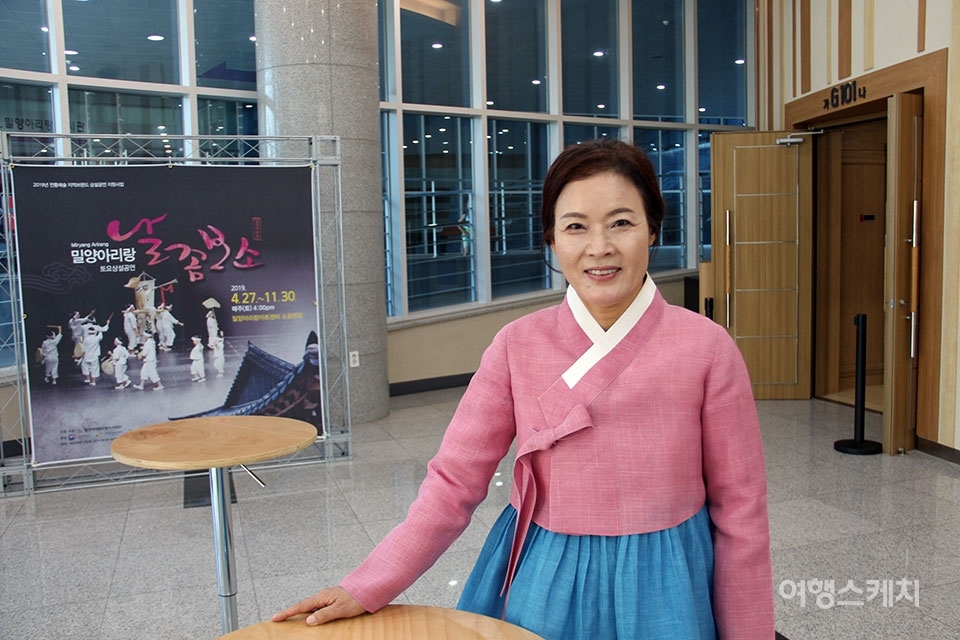
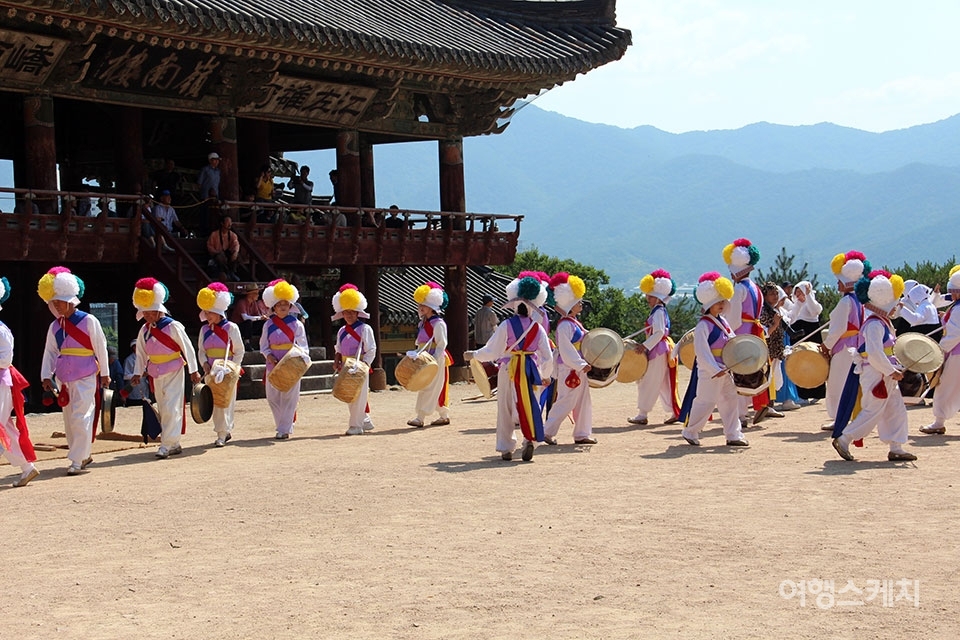

애절한 가사 또한 밀양아리랑의 특징 중 하나이다. 마치 한 여자가 유학하고 온 이웃집 남자를 향해 자신의 사랑과 간절함을 표현하는 듯하다.
The mournful lyrics are also one of the characteristics of Miryang Arirang. It is as if a woman expresses her love and longing for the man next door after studying abroad.
날 좀 보소 날 좀 보소 날 좀 보소/동지섣달 꽃 본 듯이 날 좀 보소(후렴)
정든 임이 오시는데 인사를 못 해/행주치마 입에 물고 입만 방긋(후렴)
“Look at me please. Look at me please. Look at me please. Look at me please, like a flower in the winter solstice.
My beloved one came, but I couldn't greet. Biting my apron, I smiled only with my mouth.”
오늘의 밀양아리랑 가락은 60년대 어느 작곡가가 악보를 만들어서 정형화되었다고 한다. 첫음절이 ‘라’로 시작해 흥을 돋우고, 마지막 음절도 ‘라’로 끝내면서 여운을 남긴다. 세마치장단에 맞추어 비교적 빠르며 경쾌하다.
Today's melodies of Miryang Arirang are said to have been stereotyped by a composer in the '60s who made sheet music. The first syllable begins with "La" and stimulates the excitement, leaving a lingering feeling as the last syllable ends with "La." It’s relatively fast and light, along with the Semachi rhythm.
김금희 밀양아리랑아트센터 단장은 “밀양아리랑은 경상도의 대표 민요입니다. 현재의 노래이고, 미래에도 불리어야 하는 노래입니다. 어린이와 젊은이들이 계속 밀양아리랑에 관심을 갖고, 배우고 있습니다.”라고 설명을 더한다.
"Miryang Arirang is the representative folk song of Gyeongsang Province," said Kim Geum-hee, head of the Miryang Arirang Art Center. “It's a song that needs to be sung in the future. Children and young people continue to pay attention and learn about the Miryang Arirang."
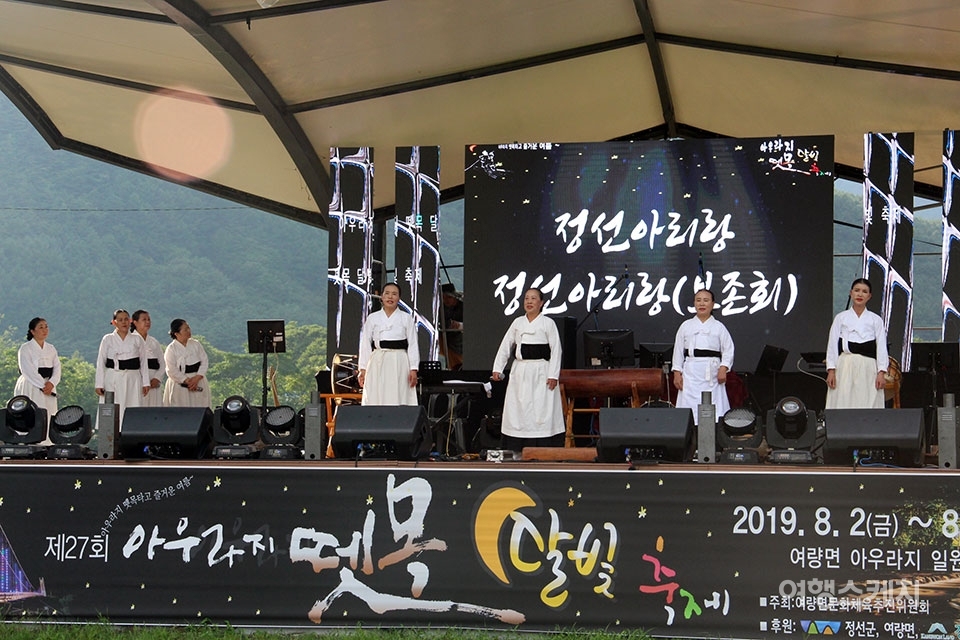
산 비탈길을 흐르는 노래, 정선아리랑
정선아리랑은 강원도 정선지방에 전승되는 민요이다. 부르는 사람이나 듣는 사람이나 구성진 곡조에 취하는 노래. 고려가 멸망할 때에 이를 한탄한 송도의 선비들이 지어 부른 노래가 강원도 계곡과 산비탈에 녹아 흐른다.
Jeongseon Arirang is a folk song that is passed down in Jeongseon, Gangwon Province. The singers and listeners are intoxicated by the song. When Goryeo was destroyed, a song written by a group of scholars from Songdo melted into the valleys and hills of Gangwon Province.
정선 사람들 말을 빌리자면 콩밭 매는 할머니도 흥얼거리고, 시장에서 생선 파는 아저씨도 아리랑을 입에 달고 산다. 정선읍내에는 아리랑과 아리랑창극을 공연하는 정선아리랑센터가 있고, 한쪽에 아리랑박물관이 있다.
The grandmother who works in the fields is humming, and the old man who sells fish at the market also has Arirang on his mouth. In Jeongseon-eup, there is the Jeongseon Arirang Center, where people perform Arirang and Arirang Changgeuk (play), and on one side, there is the Arirang Museum.
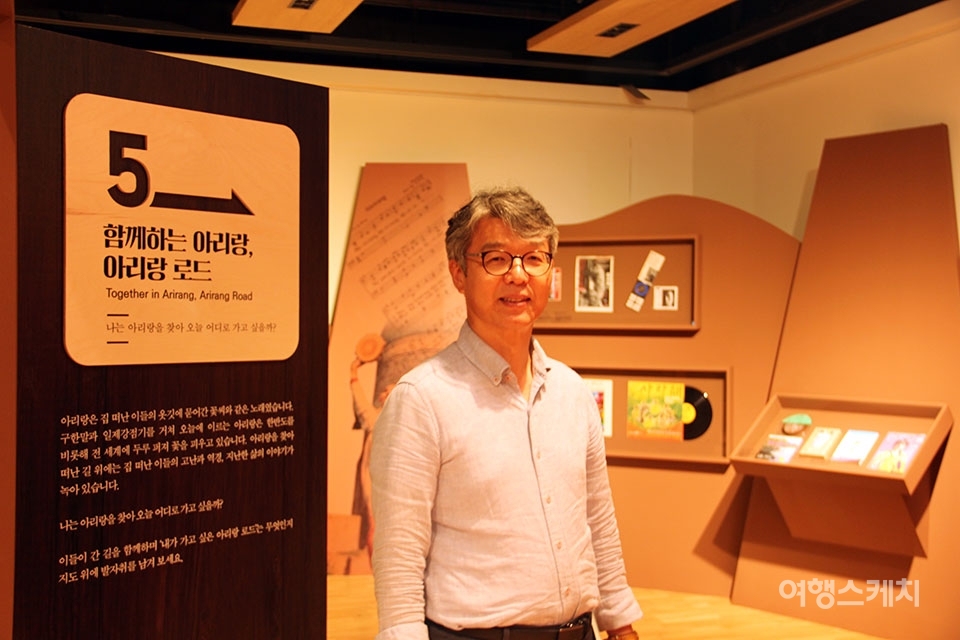

박물관의 사료는 진용선 정선아리랑박물관장이 20년에 걸쳐 수집한 것이다. “일제강점기에 아리랑은 우리 민족의 공통 언어와도 같았습니다, 나라 잃은 설움을 달래주기도 하고, 저항의식을 일깨워주기도 했지요.” 진용선 관장은 단순하면서도 구성진 곡조에 저마다 삶의 애환을 담아 부르기도 하고, 애절한 사랑을 노래하기도 했다고 말한다.
The museum's historical records have been gathered over the 20 years by Jin Yong-seon, the head of Jeongseon Arirang Museum. "Arirang went on like the common language of our people in the Japanese occupation. It also helped soothe the sorrows of the country's loss and remind us of the sense of resistance." Jin Yong-sun said, "In simple yet composed tunes, each sang the sorrows of life, and also sang the mournful love."
정선아리랑의 가락이 애절한 데는 까닭이 있다. 600여 년 전 고려조가 망하고, 관직을 내려놓은 선비들은 강원도 일대로 숨어들었다. 시들어버린 국운과 벼슬을 잃은 개인의 운을 한탄하며 노래를 흥얼거렸다. 한탄과 시름이 구슬프고 구성진 가락의 밑바탕이 된 것이다.
There is a reason why Jeongseon Arirang's lyrics are so sad. More than 600 years ago, the scholars who laid down their government posts went into hiding in Gangwon Province. They hummed the song, lamenting the withering fortunes of the nation and the individual who had lost his country. The lamentation and the sourness of the song became the foundation of the lyric that was composed.
눈이 올라나 비가 올라나 억수장마 질라나 / 만수산 검은 구름이 막 모여 든다
아리랑 아리랑 아라리요 아리랑 고개고개로 나를 넘겨주게
“It's snowing or raining. It's rainy. Black clouds of Mountain Mansu are gathering.
Arirang, Arirang, Arariyo, Let me go over Arirang hill.”

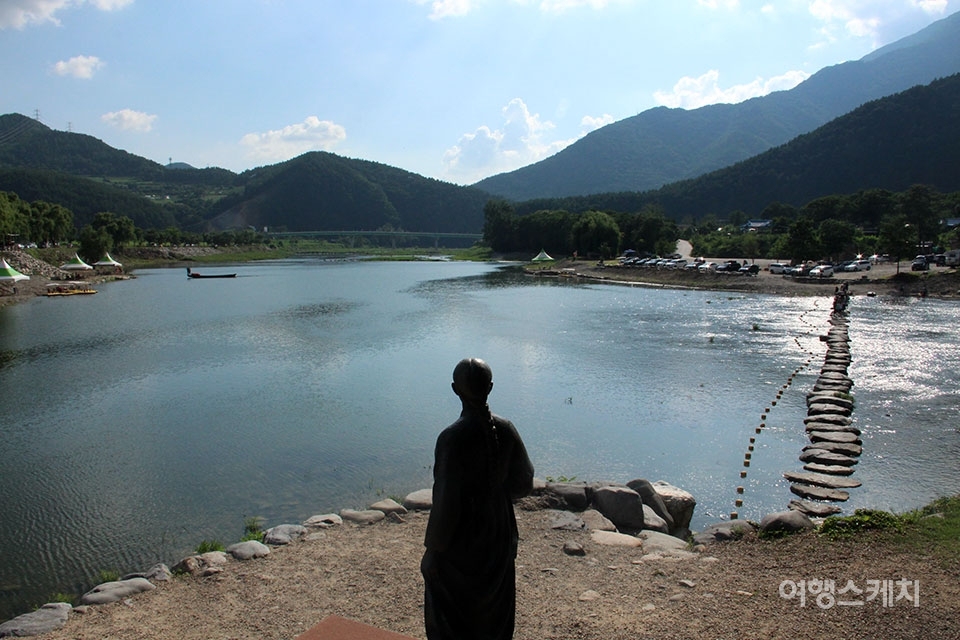
선비들의 가락은 금세 백성들에게 스며들었고, 이후 다양한 삶의 모습이 가사에 담겼다. 정선아리랑연구소가 1991년부터 2013년까지 정선군과 중국 동북 3성에서 채록 조사한 결과, 정선아리랑의 이름으로 2만3000여 수가 채록되었고, 5500여 수가 서로 다른 가사로 보고되었다.
The melodies of the scholars quickly permeated the people, and later various aspects of life were included in the lyrics. According to a survey of the Chagok in Jeongseon County and the three northeastern Chinese provinces from 1991 to 2013, 23,000 songs were recorded under the name of Jeongseon Arirang, with 5,500 reported with different lyrics.
정선아리랑은 유네스코 문화유산으로 등재되기 전인 1971년 강원도 무형 문화재 제1호로 지정되었다. 전국 다른 지역보다 먼저 아리랑 발굴과 전수에 관심을 가진 정선은 아리랑 덕을 톡톡히 보고 있다. 정선아리랑센터에선 새로운 아리랑창극을 공연하고, 박물관에서는 관련 콘텐츠를 전시하고 있다.
Jeongseon Arirang was designated as Gangwon Province Intangible Cultural Property No. 1 in 1971, before it was listed as a UNESCO heritage. Jeongseon, interested in finding and transferring Arirang ahead of other parts of the country, owes much to Arirang. The Jeongseon Arirang Center performs a new Arirang Changgeuk, while the museum is displaying related content.
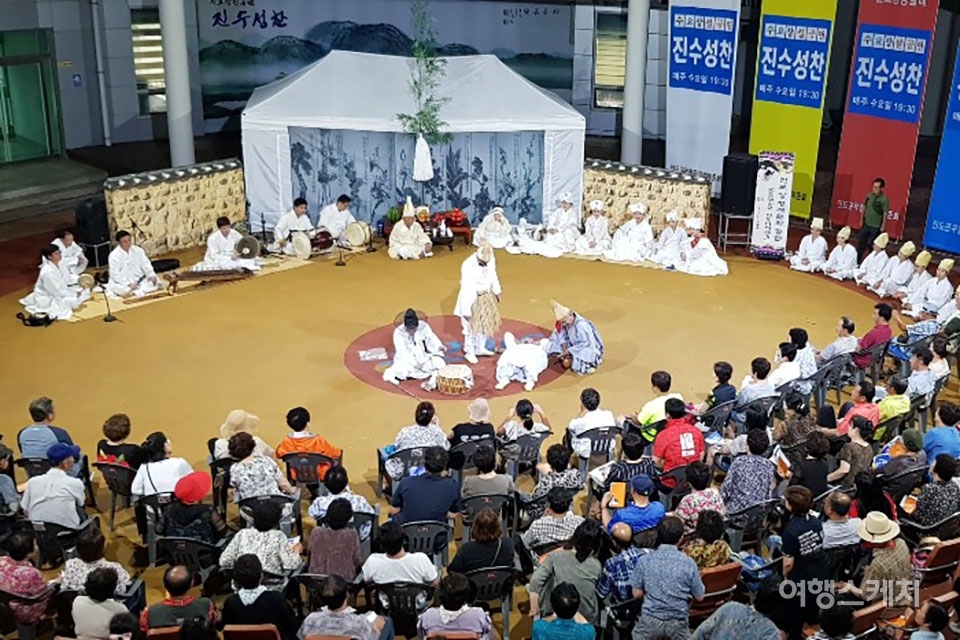
보배섬에 덩실덩실 울려 퍼지는 진도아리랑
Reverberating on the Island of Bobae, Jindo Arirang
진도 사람들은 진도를 예향이라고 말하는 데 주저함이 없다. 진도읍내 유명 한식당에 가면 북과 장구가 있고, 식사 전 누군가 북채를 잡고 “소리 한 곡 해 볼란가?” 하면 흔쾌히 한 곡을 뽑는다. 소리를 할 줄 모르면 진도 사람이 아닐 테고, 예와 흥을 모르는 사람 취급을 받는다.
The people of Jindo have no hesitation in saying that Jindo is the home of art. If you go to a famous Korean restaurant in Jindo-eup, you will find drums and janggu, and if someone grabs the drum before you eat, you will happily pick a song. If you don't know how to sing, you'll be treated like a person who doesn't know how to enjoy life.
진도아리랑은 진도 4락(樂) 중 진도민요의 범주에 들어 있으며 진도 출신의 젓대(대금) 명인인 박종기 씨가 정형화시켰다고 전해진다. 세마치장단에도 맞고 중모리장단에도 맞는데, 2행 1연의 장절 형식으로 되어 있다. 주로 여러 사람이 어울려 놀 때 즐겨 부른다.
Jindo Arirang is in the category of Jindo Minyo among the four kinds of music in the province. Park Jong-ki, a daegeum (Korean traditional woodwind instrument) master from Jindo, is said to have stereotyped it. It also fits Semachi rhythm and Jungmori rhythm, which is in the form of a two-stringed long verse. It’s usually played when people hang out.
“아리아리랑 쓰리쓰리랑 아라리가 났네/아리랑 응응응 아라리가 났네.” 가장 일반적인 노래는 이렇게 부른다. 이렇게 시작된 노래는 분위기를 띄우고 본격적인 사설이 불리기 시작한다. 선소리꾼이 두 장단을 메기면 여러 사람이 두 장단을 후렴으로 받는다.
“Ari ari rang ari ari rang, Arari appeared. Arirang um um um Arari appeared.” The song that started like this will boost the mood and go on to the next lyrics. When a front-runner carries two measures, several people receive two.

진도아리랑은 얼핏 듣기에 경쾌한 가락이나 서너 번 반복해서 들으면 한이 느껴진다. 가사에는 남녀의 사랑과 이별이 가장 많고, 애절함과 한이 담겨 있는가 하면, 익살과 해학이 넘쳐나기도 한다. 경복궁 복원 때는 밀양·정선 등 전국에서 불려온 사내들이 각 지역 아리랑을 부르며 고향에 대한 향수를 달랬다고 한다.
Jindo Arirang is a cheerful tune to listen to at first, but three or four iterations make people sympathize for it. The lyrics have the love and separation between men and women, and are filled with sorrow and resentment, while the lyrics are full of humor. During the restoration of Gyeongbok Palace, men from all over the country, including Miryang and Jeongseon, sang Arirang in their respective regions and asked for nostalgia for their hometowns.
노래를 선창한 사람의 목소리가 구성지고 처량할수록 노래를 함께 부르는 사람들과 관객의 마음이 미어진다. 이때 함께 후렴구를 부르며 슬픔을 나눠가지고 힘을 보태준다.
As the voice of the first-runner is composed and wistful, the hearts of the people who sang the song and the audience became more emotional. At this time, people sing chorus together and share their sorrows to add strength.

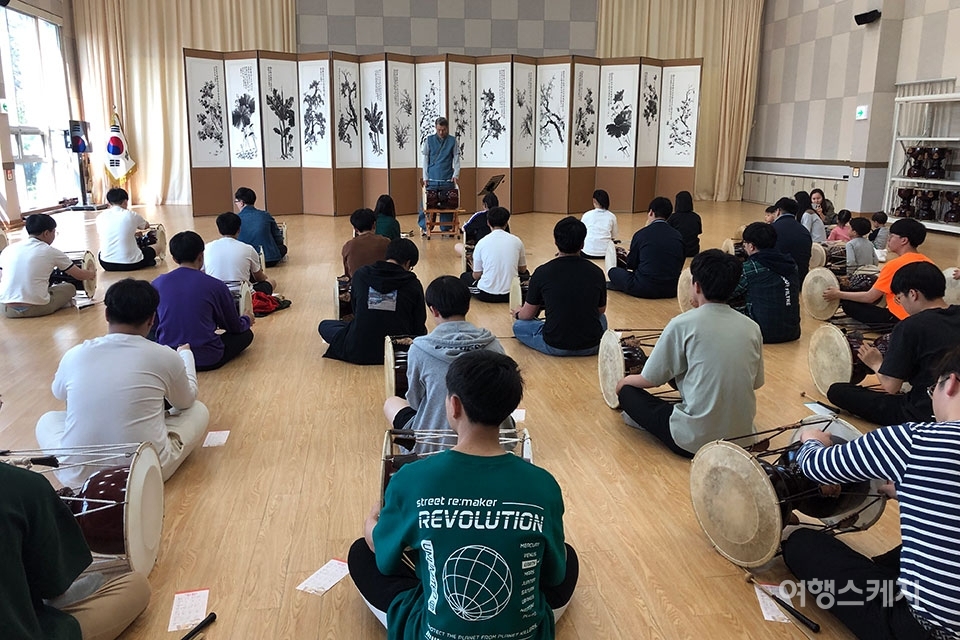
진도향토문화회관에서는 매주 토요일 오후 2시부터 진도토요민속여행 공연을 한다. 진도군립예술단원들이 판소리, 진도들노래, 진도북놀이 등을 공연한다. 이때 진도아리랑이 마지막 피날레를 장식하고, 관객들이 함께 따라 부르며 하나 되는 시간을 갖는다.
The Jindo Local Cultural Center holds performances every Saturday from 2 p.m. Members of the Jindo County Art Troupe perform pansori, Jindo dul-play and Jindo drum-play. Jindo Arirang decorates the final finale, and the audience sing along and have a time as one.
❖본 기획 취재는 국내 콘텐츠 발전을 위하여 (사)한국잡지협회와 공동 진행되었습니다.


